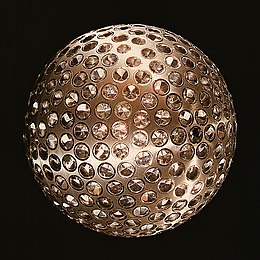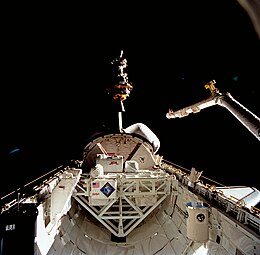LAGEOS (/leɪʒiːoʊs/), Laser Geodynamics SatelliteorLaser Geometric Environmental Observation Survey, are a series of two scientific research satellites designed to provide an orbiting laser ranging benchmark for geodynamical studies of the Earth. Each satellite is a high-density passive laser reflector in a very stable medium Earth orbit (MEO).

LAGEOS-1 (diameter=60 cm [23.6 inches])
| |
| Mission type | Geodesy |
|---|---|
| COSPAR ID | 1976-039A |
| SATCAT no. | 8820 |
| Website | ilrs.cddis.eosdis.nasa.gov |
| Mission duration | 48 years, 2 months and 17 days (in progress) |
| Spacecraft properties | |
| Spacecraft type | GEOS |
| Manufacturer | NASA |
| Launch mass | 406.965 kilograms (897.20 lb) |
| Dimensions | 0.60 metres (2 ft 0 in) diameter sphere |
| Start of mission | |
| Launch date | 4 May 1976, 08:00 (1976-05-04UTC08Z) UTC[1] |
| Rocket | Delta 2913 / Star-24 |
| Launch site | Vandenberg SLC-2W |
| Contractor | NASA |
| End of mission | |
| Disposal | Re-Entry |
| Decay date | in 8 Million Years |
| Orbital parameters | |
| Reference system | Geocentric |
| Regime | Medium Earth |
| Semi-major axis | 12,271.15 kilometers (7,624.94 mi) |
| Eccentricity | 0.0044560 |
| Perigee altitude | 5,838.33 kilometers (3,627.77 mi) |
| Apogee altitude | 5,947.69 kilometers (3,695.72 mi) |
| Inclination | 109.83 degrees |
| Period | 225.70 minutes |
| Epoch | 5 May 2017, 07:05:23 UTC[2] |
| Instruments | |
| |

Deployment of LAGEOS 2 during STS-52
| |
| Mission type | Geodesy |
|---|---|
| Operator | NASA |
| COSPAR ID | 1992-070B |
| SATCAT no. | 22195 |
| Website | ilrs.cddis.eosdis.nasa.gov |
| Mission duration | 31 years, 8 months and 29 days (in progress) |
| Spacecraft properties | |
| Spacecraft type | LAGEOS |
| Manufacturer | Aeritalia for the Italian Space Agency (ASI) |
| Launch mass | 405.38 kilograms (893.7 lb) |
| Dimensions | 0.60 metres (2 ft 0 in) diameter sphere |
| Start of mission | |
| Launch date | 22 October 1992, 17:09 (1992-10-22UTC17:09Z) UTC[1] |
| Rocket | Space Shuttle STS-52 / Italian Research Interim Stage (IRIS) |
| Launch site | Kennedy LC-39B |
| End of mission | |
| Disposal | Re-Entry |
| Decay date | in 8 Million years |
| Orbital parameters | |
| Reference system | Geocentric |
| Regime | Medium Earth |
| Semi-major axis | 12,161.84 kilometers (7,557.02 mi) |
| Eccentricity | 0.0137298 |
| Perigee altitude | 5,616.73 kilometers (3,490.07 mi) |
| Apogee altitude | 5,950.68 kilometers (3,697.58 mi) |
| Inclination | 52.65 degrees |
| Period | 222.46 minutess |
| Epoch | 5 May 2017, 07:48:20 UTC[2] |
| Instruments | |
| |

The spacecraft are aluminum-covered brass spheres with diameters of 60 centimetres (24 in) and masses of 400 and 411 kilograms (882 and 906 pounds), covered with 426 cube-corner retroreflectors, giving them the appearance of disco balls.[3][4][5] Of these retroreflectors, 422 are made from fused silica glass while the remaining 4 are made from germanium to obtain measurements in the infrared for experimental studies of reflectivity and satellite orientation.[6] They have no on-board sensors or electronics, and are not attitude-controlled.
They orbit at an altitude of 5,900 kilometres (3,700 mi),[7] well above low Earth orbit and well below geostationary orbit, at orbital inclinations of 109.8 and 52.6 degrees.
Measurements are made by transmitting pulsed laser beams from Earth ground stations to the satellites. The laser beams then return to Earth after hitting the reflecting surfaces; the travel times are precisely measured, permitting ground stations in different parts of the Earth to measure their separations to better than one inch in thousands of miles.
The LAGEOS satellites make it possible to determine positions of points on the Earth with extremely high accuracy due to the stability of their orbits. The high mass-to-area ratio and the precise, stable (attitude-independent) geometry of the LAGEOS spacecraft, together with their extremely regular orbits, make these satellites the most precise position references available.
The LAGEOS mission consists of the following key goals:
Ground tracking stations located in many countries (including the US, Mexico, France, Germany, Poland, Australia, Egypt, China, Peru, Italy, and Japan) have ranged to the satellites and data from these stations are available worldwide to investigators studying crustal dynamics.
There are two LAGEOS spacecraft, LAGEOS-1 launched in 1976, and LAGEOS-2 launched in 1992. As of 2023[update], both LAGEOS spacecraft are routinely tracked by the ILRS network.[8]
LAGEOS-1 (which is predicted to re-enter the atmosphere in 8.4 million years[6]) also contains a 4 in × 7 in plaque designed by Carl Sagan[9] to indicate to future humanity when LAGEOS-1 was launched. The plaque includes the numbers 1 to 10 in binary. In the upper right is a diagram of the Earth orbiting the Sun, with a binary number 1 indicating one revolution, equaling one year. It then shows 268,435,456 years in the past (binary: 228), indicated by a left arrow and the arrangement of the Earth's continents at that time (during the Permian period). The present arrangement of the Earth's continents is indicated with a 0 and both forward and backward arrows. Then the estimated arrangement of the continents in 8.4 million years with a right facing arrow and 8,388,608 in binary (223). LAGEOS itself is shown at launch on the 0 year, and falling to the Earth in the 8.4 million year diagram.[10][11]